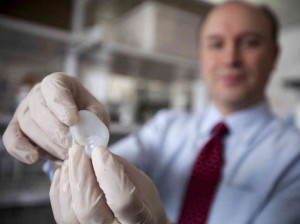Podcast: Play in new window
BOB HIRSHON (host):
Ears made to order. I’m Bob Hirshon and this is Science Update.
3-D printers haven’t yet matched the sophistication of the replicators found on “Star Trek”. Nonetheless, they’re already being used to re-create body parts. For instance, the lab of biomedical engineer Larry Bonassar at Cornell has successfully reproduced a human ear with a 3-D printer. To do so, his team took 3-D photos of an ear and created a printable computer model. He says collagen serves as a sort of “ink”.
LARRY BONASSAR (Cornell University):
And we encapsulate ear cartilage cells in this collagen, and we can dispense that material either out of a printer or inject it into a mold that’s the right shape.
HIRSHON:
It takes several months for the cartilage to grow and replace the collagen. So far, they’ve successfully implanted the ears in rats, and they hope to implant them in humans within five years. The ultimate goal is to help children born with underdeveloped outer ears. I’m Bob Hirshon, for AAAS, the science society.

